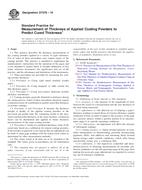Potrebujeme váš súhlas na využitie jednotlivých dát, aby sa vám okrem iného mohli ukazovať informácie týkajúce sa vašich záujmov. Súhlas udelíte kliknutím na tlačidlo „OK“.
ASTM D7378-10
Standard Practice for Measurement of Thickness of Applied Coating Powders to Predict Cured Thickness
Automaticky preložený názov:
Štandardná prax pre meranie hrúbky aplikovaných práškovej farby predvídať hrúbky tvrdeného
NORMA vydaná dňa 1.12.2010
Informácie o norme:
Označenie normy: ASTM D7378-10
Poznámka: NEPLATNÁ
Dátum vydania normy: 1.12.2010
Kód tovaru: NS-38318
Počet strán: 4
Približná hmotnosť: 12 g (0.03 libier)
Krajina: Americká technická norma
Kategória: Technické normy ASTM
Kategórie - podobné normy:
Anotácia textu normy ASTM D7378-10 :
Keywords:
coating powder, coating thickness, film thickness, powder coating, powder thickness, thickness prediction, ultrasonic, Coating powders, Coating thickness, ICS Number Code 17.040.20 (Properties of surfaces)
Doplňujúce informácie
| Significance and Use | ||||||
|
Many physical and appearance properties of the finished coating are affected by the film thickness. Film thickness can affect the color, gloss, surface profile, adhesion, flexibility, impact resistance and hardness of the coating. The fit of pieces assembled after coating can be affected when film thickness is not within tolerance. Therefore coatings must be applied within certain minimum and maximum film thickness specifications to optimize their intended use. All procedures involve taking measurements of applied coating powders in the pre-cured, pre-gelled state to help insure correct cured film thickness. This enables the application system to be set up and fine-tuned prior to the curing process. In turn, this will reduce the amount of scrap and over-spray. Accurate predictions help avoid stripping and re-coating which can cause problems with adhesion and coating integrity. Measurements of cured powder coating thickness can be made using different methods depending upon the substrate. Non-destructive measurements over metal substrates can be made with magnetic and eddy current coating thickness gages (see Practice D7091). Non-destructive measurements over non-metal substrates can be made with ultrasonic coating thickness gages (see Test Method D6132). Destructive measurements over rigid substrates can be made with cross-sectioning instruments (see Practices D4138). |
||||||
| 1. Scope | ||||||
|
1.1 This practice describes the thickness measurement of dry coating powders applied to a variety of rigid substrates. Use of some of these procedures may require repair of the coating powder. This practice is intended to supplement the manufacturers’ instructions for the operation of the gages and is not intended to replace them. It includes definitions of key terms, reference documents, the significance and use of the practice, and the advantages and limitations of the instruments. 1.2 Three procedures are provided for measuring dry coating powder thickness: 1.2.1 Procedure A—Using rigid metal notched (comb) gages. 1.2.2 Procedure B—Using magnetic or eddy current dry film thickness gages. 1.2.3 Procedure C—Using non-contact ultrasonic powder thickness instruments. 1.3 Coating powders generally diminish in thickness during the curing process. Some of these procedures therefore require a reduction factor be established to predict cured film thickness of powder coatings. 1.4 Procedure A and Procedure B measure the thickness (height or depth) of the applied coating powders in the pre-cured, pre-gelled state. By comparing results to the measured cured powder thickness in the same location, a reduction factor can be determined and applied to future thickness measurements of the same coating powder. 1.5 Procedure C results in a predicted thickness value of the cured state based on a calibration for typical coating powders. If the powder in question is not typical then an adjustment can be made to align gage readings with the actual cured values as determined by other measurement methods. 1.6 The values stated in SI units are to be regarded as the standard. The values given in parentheses are for information only. 1.7 This standard does not purport to address all of the safety concerns, if any, associated with its use. It is the responsibility of the user of this standard to establish appropriate safety and health practices and determine the applicability of regulatory limitations prior to use. |
||||||
| 2. Referenced Documents | ||||||
|
Odporúčame:
Aktualizácia technických noriem
Chcete mať istotu, že používate len platné technické normy?
Ponúkame Vám riešenie, ktoré Vám zaistí mesačný prehľad o aktuálnosti noriem, ktoré používate.
Chcete vedieť viac informácií ? Pozrite sa na túto stránku.




 Cookies
Cookies
